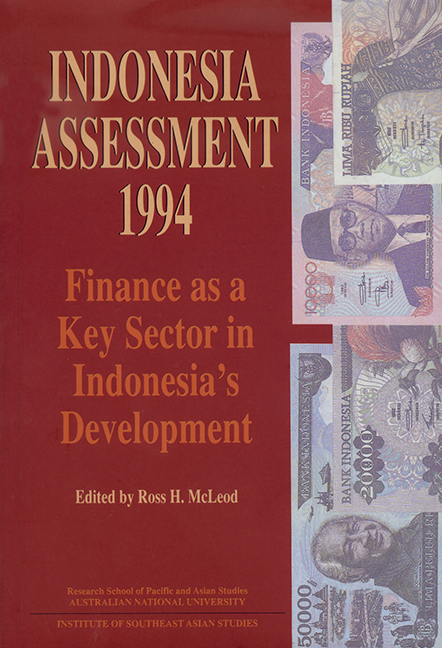Book contents
- Frontmatter
- Contents
- Tables, figures, appendices
- Foreword
- Glossary
- Contributors
- Acknowledgements
- 1 Introduction
- PART A ECONOMIC AND POLITICAL DEVELOPMENTS
- PART B FINANCE AS A KEY SECTOR IN INDONESIA'S DEVELOPMENT
- I The Reform Process
- II Monetary and Exchange Rate Policy
- III Banking Sector Reforms
- IV Domestic and International Capital Markets
- 12 The role of the Indonesian capital market
- 13 Indonesian capital market development and privatisation
- 14 Problems and prospects for the life insurance and pensions sector in Indonesia
- 15 Indonesia's foreign debt
- V Small-scale Finance
- References
- Index
13 - Indonesian capital market development and privatisation
from IV - Domestic and International Capital Markets
Published online by Cambridge University Press: 21 October 2015
- Frontmatter
- Contents
- Tables, figures, appendices
- Foreword
- Glossary
- Contributors
- Acknowledgements
- 1 Introduction
- PART A ECONOMIC AND POLITICAL DEVELOPMENTS
- PART B FINANCE AS A KEY SECTOR IN INDONESIA'S DEVELOPMENT
- I The Reform Process
- II Monetary and Exchange Rate Policy
- III Banking Sector Reforms
- IV Domestic and International Capital Markets
- 12 The role of the Indonesian capital market
- 13 Indonesian capital market development and privatisation
- 14 Problems and prospects for the life insurance and pensions sector in Indonesia
- 15 Indonesia's foreign debt
- V Small-scale Finance
- References
- Index
Summary
From 1987 through 1993, the number of listed companies and market capitalisation on the Jakarta Stock Exchange (JSX) rose from 24 to 174 issuers and from $68 million to $33 billion. Indonesian securities regulation developed in parallel with this growth during the capital market's infancy, but now faces adolescence. This paper seeks to clarify problems of market development, given the sometimes conflicting policies embedded in existing regulations.
Indonesian capital market and privatisation policies followed different paths until relatively recently. However, the pending equity offering of the state-owned telecommunications enterprise PT Indosat (Linnan 1994), to be listed on the JSX and New York Stock Exchange (NYSE), has produced a circumstance in which domestic regulation is being subjected to comparison with foreign practice. Dual listing privatisation plans and concurrent offerings abroad by private issuers have the unintended consequence of focusing attention on the question whether, by raising the cost of capital, existing non- market based Indonesian regulation pushes established issuers into foreign capital markets, while disadvantaging smaller issuers and affecting domestic market development adversely. Arguably, globalisation in the form of competition between capital market regulatory structures in Indonesia and elsewhere will improve Indonesian practices in the near to medium term.
Issues for Capital Market Development and Privatisation
Regulatory development in the capital market is complicated by the idea that, alongside ‘best practice’ issues, securities regulation also may be shaped by broader policy considerations. In the Indonesian context, these include the sometimes inconsistent concerns of equity, economic efficiency, economic concentration, and nationalism. This paper takes the position that the result thus far has been potentially to limit development of the capital market.
What is meant by the distinction between ‘market based’ and ‘non-market based’ capital market regulation? For present purposes, ‘market based’ regulation is defined as disclosure-oriented regulation, which assumes that the objective is to support the market's function by establishing a neutral framework for the informed conduct of private parties’ economic relations, while recognising that emerging securities markets are often neither efficient nor liquid.
- Type
- Chapter
- Information
- Indonesia Assessment 1994Finance as a Key Sector in Indonesia's Development, pp. 223 - 247Publisher: ISEAS–Yusof Ishak InstitutePrint publication year: 1994

